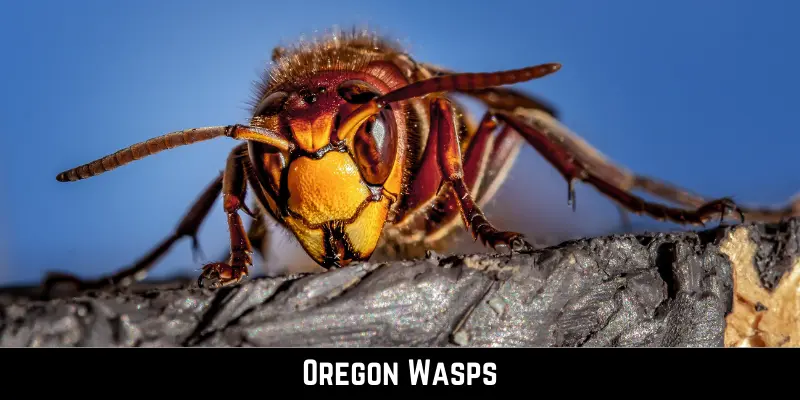Have you ever encountered a buzzing insect in Oregon and wondered, “What kind of wasp is this?” It’s a question many residents and visitors ponder: Oregon Wasps.
This beautiful Northwestern state is home to a diverse range of these insects, each with its unique characteristics and behaviors. From the commonly seen paper wasp to the less known mud dauber, Oregon’s wasps play crucial roles in local ecosystems, often acting as pollinators and natural pest controllers.
Curious about the various wasps you might encounter during your next outdoor adventure in Oregon? Continue reading to delve deeper into their fascinating world and discover more!
Why Wasps Matter in the Ecosystem?
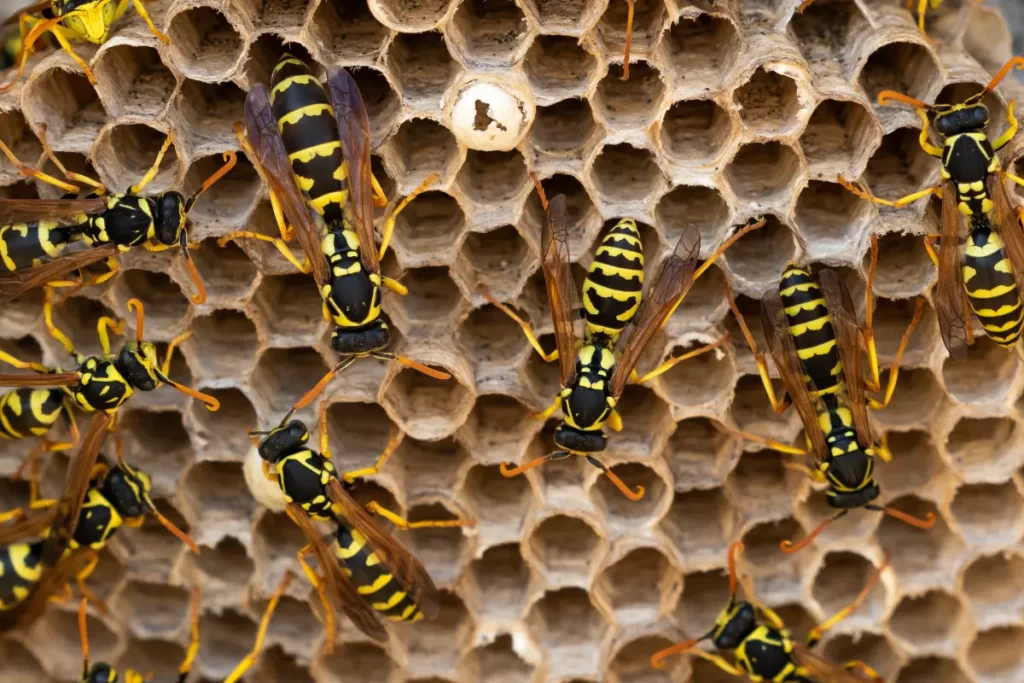
It’s easy to think they’re just pesky insects. But the truth is, wasps have big jobs in our world. Here’s why they matter so much.
First, wasps are like nature’s pest controllers. They hunt and eat many bugs that harm our gardens, like caterpillars and aphids. So, if you love seeing pretty flowers and fresh veggies, thank a wasp! They help plants stay healthy without the need for chemicals.
Second, wasps help with pollination. Just like bees, some wasps visit flowers for nectar. When they do, they spread pollen from one flower to another. This helps plants produce fruits and seeds. So, if you enjoy fruits like cherries and blackberries, remember that wasps made them.
Lastly, wasps are food for other animals. Birds, bats, and even some spiders eat wasps. This makes wasps an important link in the food chain. When wasps are around, it helps keep the balance in nature.
21 Types of Oregon Wasps
- Cuckoo Wasp
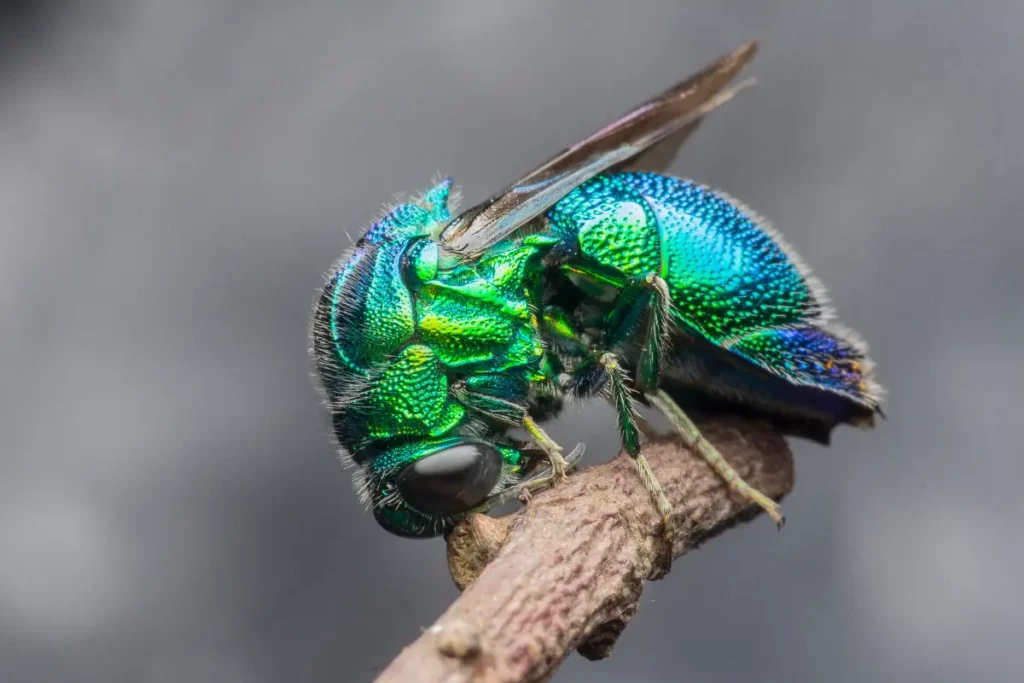
Cuckoo wasps are named after the cuckoo bird. Why? Because just like the bird, they lay their eggs in other insects’ nests. When the baby cuckoo wasps hatch, they eat the host insect’s eggs or larvae. It’s a sneaky trick, but it’s how they survive!
These wasps are often bright in color. They can be metallic green, blue, or even red. When sunlight hits them, they sparkle! It’s not just for looks, though. This shiny color can confuse predators, helping the wasp escape danger.
One more cool thing? Cuckoo wasps have a tough body. If a bird or another insect tries to eat them, they can play dead and then fly away when the coast is clear. Smart, right?
Now, let’s look at some quick facts about the cuckoo wasp’s features:
| Feature | Description |
| Size | Usually small, around 5 to 15 mm in length. |
| Color | Metallic shades of green, blue, or red. |
| Body | Hard and rounded, almost like armor. |
| Wings | Two pairs, but they are short and might look like just one. |
| Antennae | Yes, they are short and straight. |
| Legs | Six legs, which are good for walking and holding onto surfaces. |
- Paper Wasps
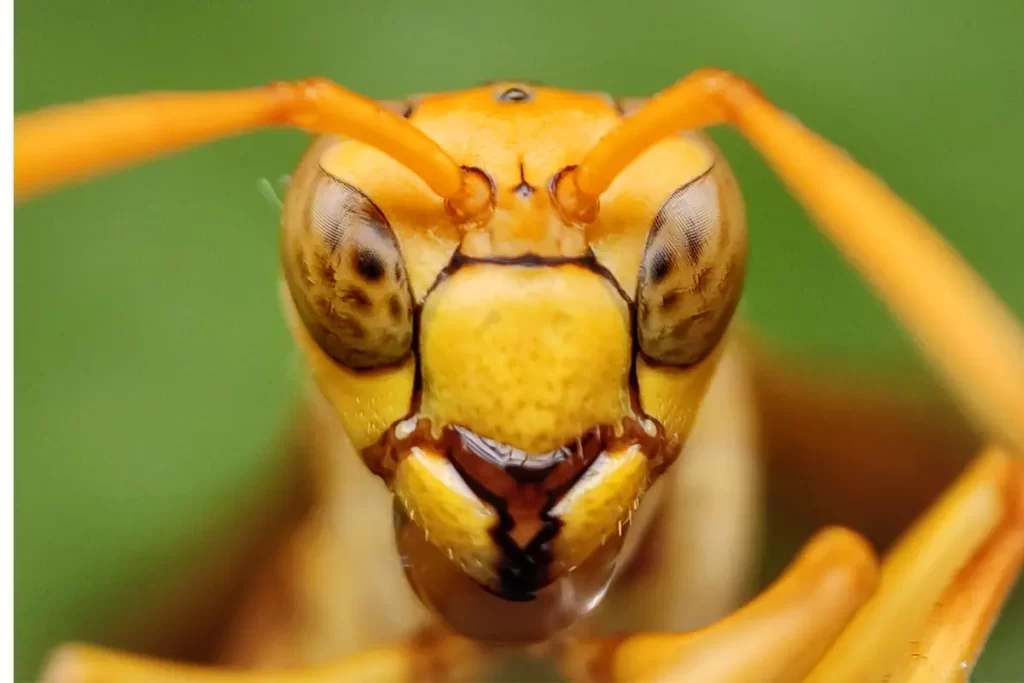
Paper wasps, scientifically known as Polistes spp., are fascinating insects found in Oregon and many other parts of the United States. These insects are known for their distinctive appearance and interesting behaviors. In this brief overview, we’ll explore some key facts about paper wasps in Oregon.
Paper wasps are slender insects with long bodies and narrow waists. They are usually brown with yellow or reddish markings. These markings can vary among different species of paper wasps. One common species in Oregon is the Northern Paper Wasp (Polistes fuscatus). They have two pairs of wings and can measure up to one inch in length.
Paper wasps are commonly found in various habitats in Oregon, including gardens, meadows, and woodlands. They build their nests in sheltered locations, such as under eaves, in tree branches, or inside structures like sheds or garages. Their nests are made from chewed-up plant fibers, giving them a papery appearance.
Now, let’s look at some quick facts about the paper wasp’s features:
| Feature | Description |
| Size | About 1.6 cm to 2 cm long. |
| Color | Mostly brown with some yellow or orange markings. |
| Body | Slender with a noticeable thin “waist”. |
| Wings | Two pairs, translucent with a slightly brown or yellow tint. |
| Antennae | Yes, they are long and often curve slightly downwards. |
| Legs | Six legs, longer than those of many other wasps. |
- Mud Daubers
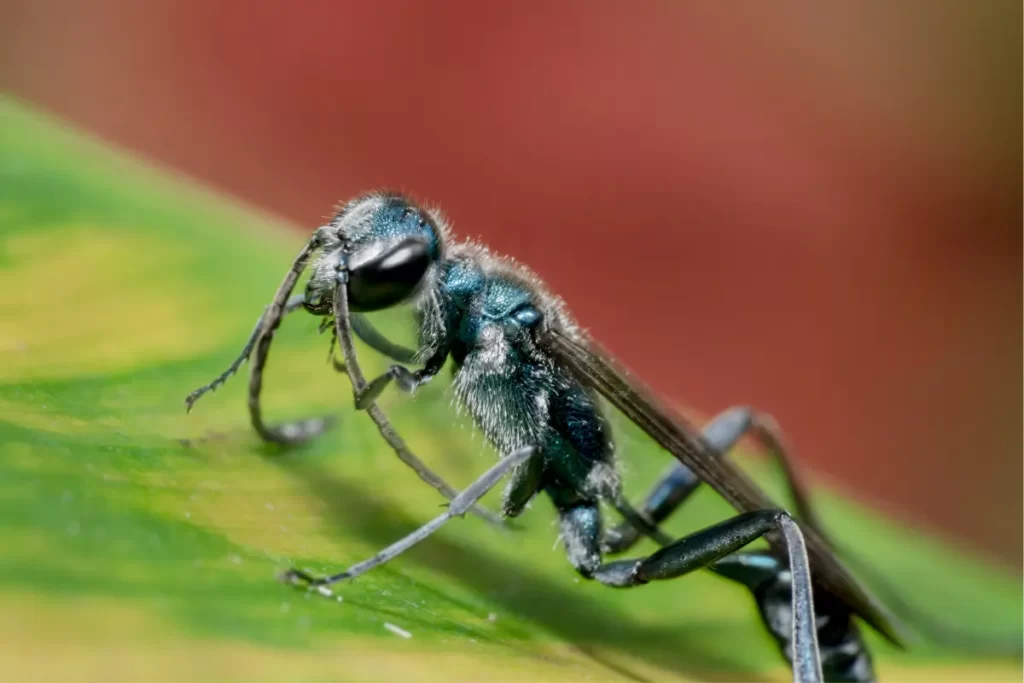
Mud daubers are amazing architects. They gather wet mud and shape it into tubes or little pots. These mud homes are where they lay their eggs. Inside each mud chamber, they also put spiders. Why? Well, when the baby wasps hatch, they have a ready-made meal!
These wasps are often black or metallic blue and have a very thin “waist.” Unlike some other wasps, mud daubers are mostly peaceful. They usually won’t sting unless they feel threatened.
Here’s a simple table to help you recognize a mud dauber:
| Feature | Description |
| Size | About 2.5 cm long. |
| Color | Black or metallic blue. Some have yellow markings. |
| Body | Long and slender with a very thin “waist”. |
| Wings | Two pairs, dark or clear depending on the type. |
| Antennae | Yes, they are long and sometimes curve a little. |
| Legs | Six legs. They hang down when the wasp flies. |
- Leucospid Wasp
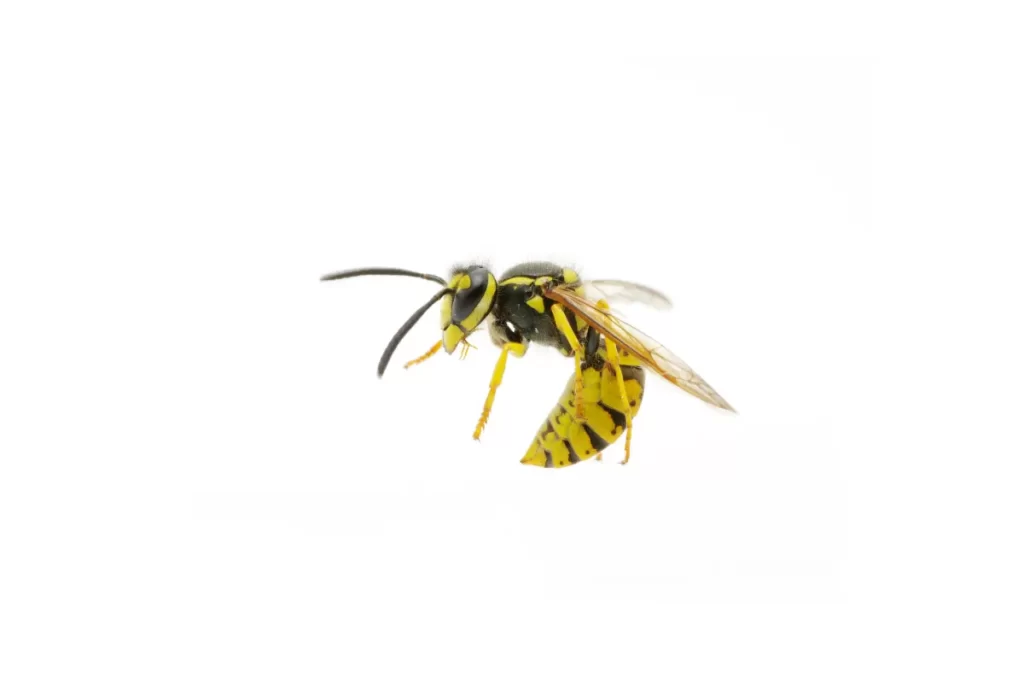
Leucospid wasps are a bit mysterious. They’re not the kind you’ll often spot in your backyard. These wasps are known for their shiny bodies and unique behavior. One interesting thing is how they lay their eggs. They place them inside the nests of other insects, mainly bees. When their babies hatch, they have food right there waiting!
They usually have a metallic look, often shiny gold or bronze. And if you ever get a chance to look closely, you’ll notice their body seems armored.
Here’s a simple guide to help you identify a Leucospid wasp:
| Feature | Description |
| Size | Usually small, around 1 to 2 cm in length. |
| Color | Metallic, often in shades of gold, bronze, or silver. |
| Body | Appears armored, with a strong shield-like shape. |
| Wings | Two pairs, mostly clear with a slight tint. |
| Antennae | Yes, they’re straight and of medium length. |
| Legs | Six legs, fairly standard in appearance for a wasp. |
- Yellowjackets
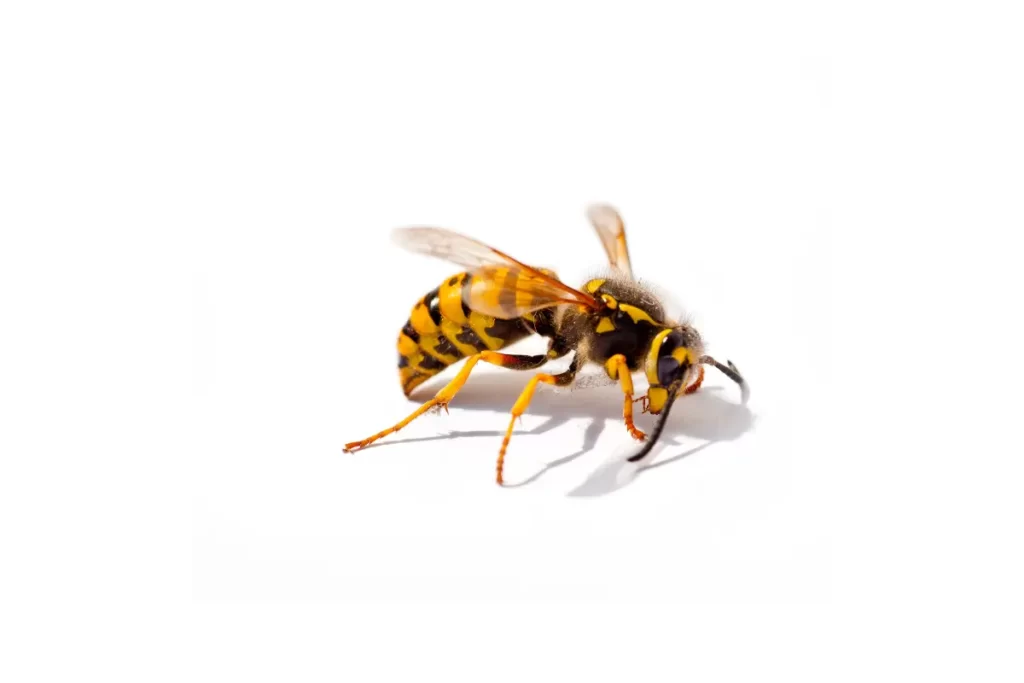
Yellowjackets are known for their bright yellow and black pattern. They’re social wasps, meaning they live in groups. In Oregon, they’re pretty common, especially in the summer and fall. They often search for food and can be drawn to our snacks. But remember, they play a helpful role in nature. They eat pests that can harm plants.
However, be careful around them. If they feel threatened, they might sting. It’s always best to keep a calm distance.Here’s a handy table to recognize a yellowjacket:
| Feature | Description |
| Size | About 1 cm to 2 cm long. |
| Color | Bright yellow with black patterns. |
| Body | Smooth and slightly shiny. |
| Wings | Two pairs, clear and a bit longer than their body. |
| Antennae | Yes, straight and black. |
| Legs | Six legs, yellow and black. |
- Hornets
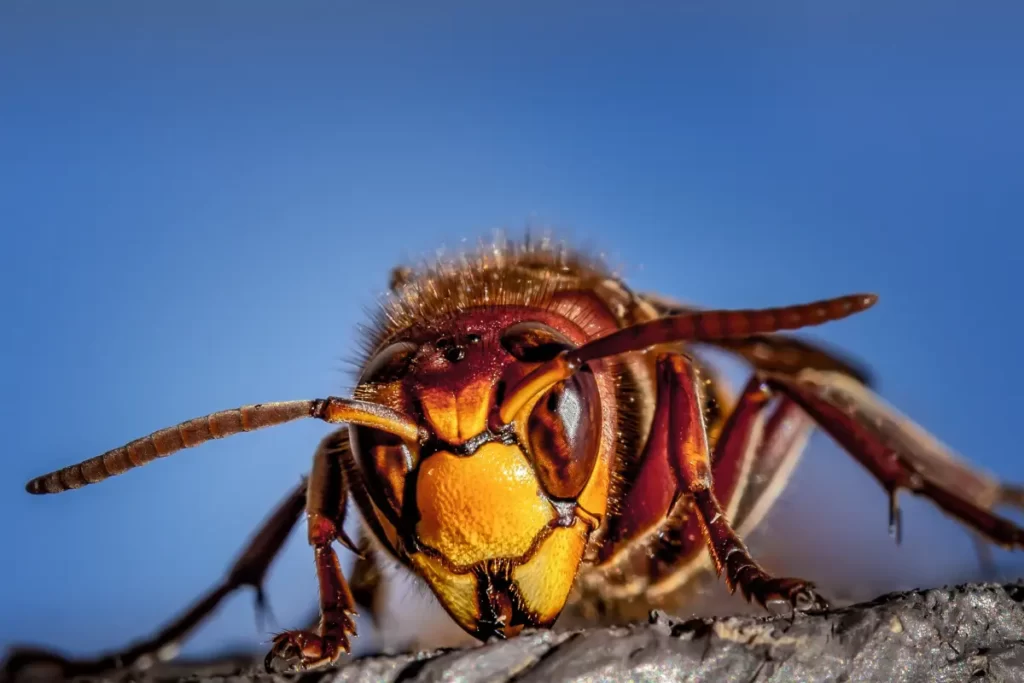
Hornets are larger than many other wasps. They’re known for their size and the buzz they make. In Oregon, they often build their nests in trees or shrubs. These nests can be big and round, made from a paper-like material. Hornets are mainly peaceful but can defend their nests if they feel it’s in danger.
They eat other insects, which helps control the population of pests. So, if you’re a gardener or just someone who loves plants, hornets are your helpers!
Here’s a quick guide to help you identify a hornet:
| Feature | Description |
| Size | About 2.5 cm to 5.5 cm long. |
| Color | Usually black with white or yellow stripes. |
| Body | Robust and slightly shiny. |
| Wings | Two pairs, clear and quite large. |
| Antennae | Yes, straight and usually black. |
| Legs | Six legs, sturdy and colored to match their body. |
- Thread-Waisted Wasp
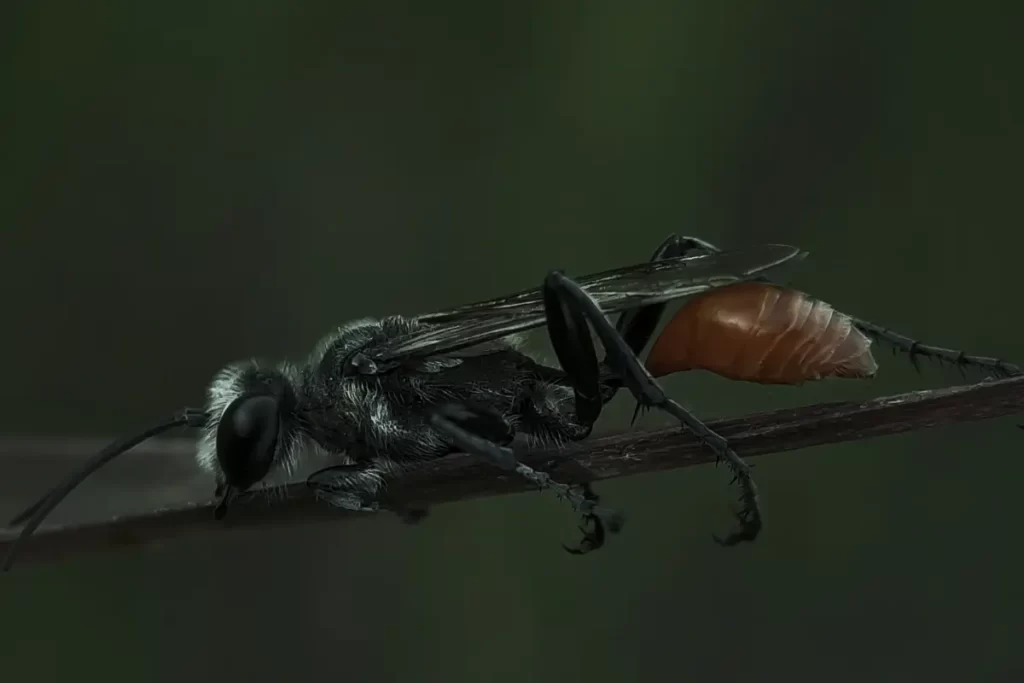
The name “thread-waisted” aptly describes this wasp. Its incredibly thin, extended waist makes it look like its front and back are barely connected, almost like a thread. This unique feature has sparked curiosity among those who have seen it. In Oregon, these wasps can be observed buzzing around flowers, gardens, and even sandy areas.
These wasps are solitary creatures. Unlike bees or some other wasps, they don’t live in large colonies. Instead, each female wasp finds a suitable place, often the ground, to lay her eggs. Before doing so, she hunts for caterpillars or spiders, paralyzes them with her sting, and places them with her egg. When the egg hatches, the young wasp has a fresh meal waiting.
Thread-waisted wasps are beneficial for the environment. They naturally control pest populations, making them a gardener’s friend. Plus, while they can sting, they’re generally not aggressive and prefer to keep to themselves.
Here’s a table for easy identification of the thread-waisted wasp:
| Feature | Description |
| Size | Ranges from 1 cm to 3 cm in length. |
| Color | Varied. Can be black, red, or even metallic green. |
| Body | Distinguished by its extremely thin “waist”. |
| Wings | Two pairs, clear, and may have a slight tint. |
| Antennae | Yes, typically long and straight. |
| Legs | Six legs, sometimes long and spindly. |
- Golden Digger Wasp
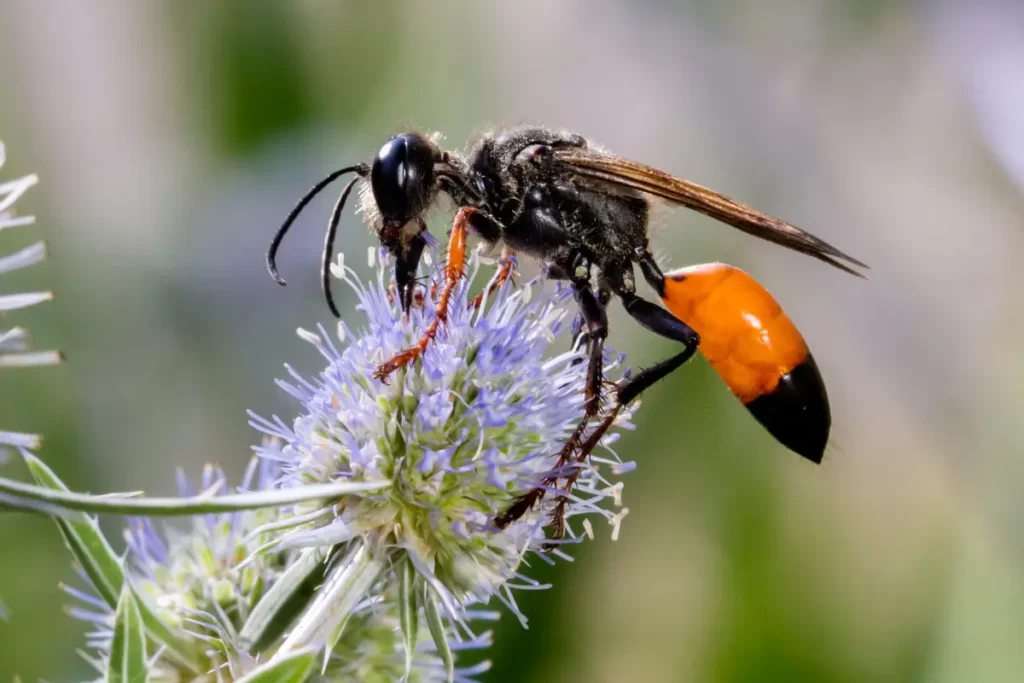
The Golden Digger Wasp gets its name from its shimmering, golden appearance and its unique behavior of digging nests in the ground. This solitary wasp is quite the architect. It skillfully constructs tunnels in sandy or loose soil, preparing a safe space for its offspring. But that’s not all. Before sealing the nest, the wasp hunts for insects, paralyzing them with its sting and placing them inside. These insects serve as a food source for the wasp’s larvae when they hatch.
While the Golden Digger Wasp’s hunting skills might sound intimidating, there’s good news for us humans: these wasps are generally non-aggressive towards people. They’re more focused on their insect prey and the task of nest-building. For gardeners, they can be helpful allies, as they control certain pests naturally.
Here’s a quick guide to help you identify the Golden Digger Wasp:
| Feature | Description |
| Size | Around 2.5 cm in length. |
| Color | Vibrant gold with black markings. |
| Body | Sleek and shiny with a clear separation between thorax and abdomen. |
| Wings | Two pairs, clear with a slight amber hue. |
| Antennae | Yes, slender and black. |
| Legs | Six legs, often with black or dark colored “feet”. |
- Bald-Faced Hornets
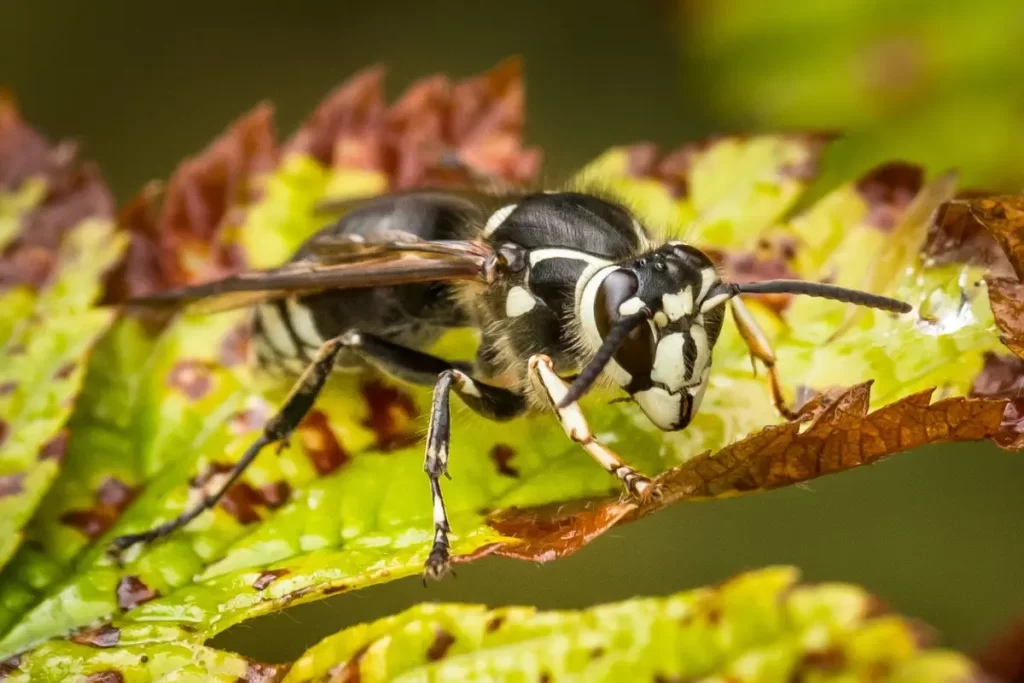
In the dense green forests and vibrant meadows of Oregon, the bald-faced hornet emerges as a master builder in the insect kingdom. Akin to aerial architects, these hornets are known for their large, impressive paper nests and distinct appearance.
Contrary to their name, bald-faced hornets are not true hornets. They’re a type of yellowjacket wasp. But what sets them apart is their striking black and white appearance.
These wasps stand out against the backdrop of Oregon’s lush landscapes. While they’re social creatures, building colonies that can house hundreds, they’re fiercely protective of their nests.
While a bald-faced hornet’s sting can be painful, it’s important to remember that they typically only attack if they perceive a threat to their home. Otherwise, they’re busy hunting for food, which includes other insects, making them natural pest controllers.
If you ever come across one of their nests, it’s best to admire them from a distance and give them the space they need.
To help you recognise the bald-faced hornet, here’s a table with its key features:
| Feature | Description |
| Size | 1.5 cm to 2 cm in length. |
| Color | Primarily black with a white face, hence “bald-faced”. |
| Body | Robust, with a clear division between segments. |
| Wings | Two pairs, translucent with a gray tint. |
| Antennae | Yes, black and fairly long. |
| Legs | Six legs, black in color. |
- Cicada Killers
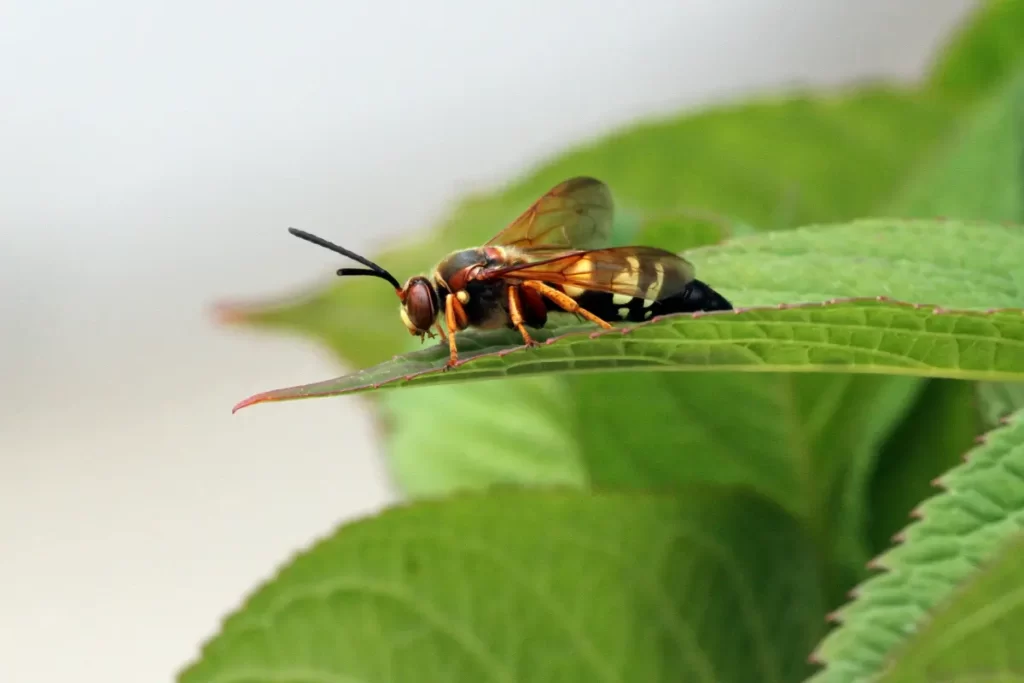
Oregon’s vast and varied landscapes are a playground for many creatures, and among them is a truly remarkable insect: the Cicada Killers Wasp. Don’t let the intimidating name scare you off; these wasps are fascinating to learn about!
The Cicada Killers Wasp has a mission in its name. It’s a hunter whose primary prey is the loud, buzzing cicadas. How does it work?
Using their strong sting, these wasps immobilize cicadas, drag them to their underground caves, and lay an egg on them. When the egg hatches, the young wasp larva has a ready-made meal waiting. It might sound a bit intense, but it’s nature’s way.
Now, while these wasps might be formidable hunters, they aren’t particularly interested in humans. They’re not aggressive and would much rather focus on cicadas. So, if you come across one, there’s no need for alarm.
| Feature | Description |
| Size | Roughly 3 cm to 5 cm in length. |
| Color | Typically brown or reddish-brown with yellow stripes. |
| Body | Solid and robust, with a noticeable waist segment. |
| Wings | Two pairs, clear, and often tinged with an orange hue. |
| Antennae | Present, sturdy, and typically brown. |
| Legs | Six, strong, designed for digging and carrying prey. |
- Horntail Wasp
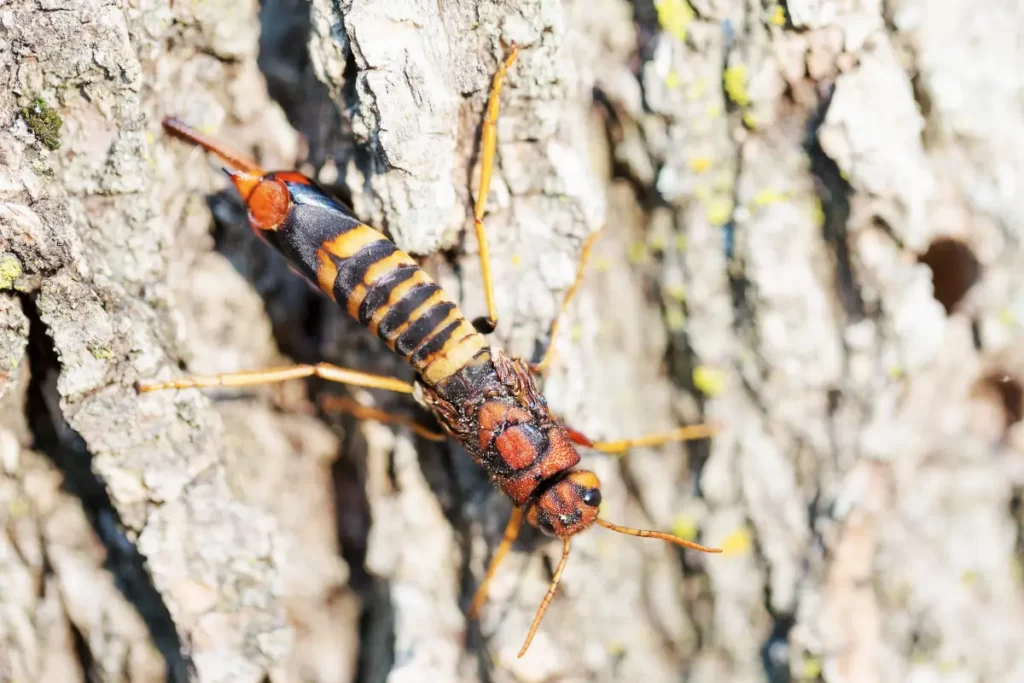
Oregon’s wilderness is home to various intriguing creatures, each with its unique story. Among them, the Horntail Wasp stands out, not for its buzz but for its relationship with wood.
Now, if you’re picturing a typical wasp, think again! Horntail Wasps, sometimes known as “wood wasps,” are slightly different. Their claim to fame is their peculiar tail, which isn’t a stinger but a tool for laying eggs.
Using this, female Horntail Wasps drill into wood, depositing their eggs. When the eggs hatch, the larvae munch on the wood, spending their early life inside until they’re ready to emerge.
While they sound intense, here’s the good news: they’re not out to sting humans. In fact, they’re quite peaceful and play an important role in Oregon’s forest ecosystem, helping break down dead trees.
To get to know the Horntail Wasp better, here’s a snapshot of their features:
| Feature | Description |
| Size | Between 2.5 cm to 4 cm in length. |
| Color | Varies, but often black or brown with yellow or orange bands. |
| Body | Long and cylindrical without a narrow waist. |
| Wings | Two pairs, clear or lightly tinted. |
| Antennae | Yes, long and often thread-like. |
| Legs | Six, usually spiny and robust. |
- Sand Wasp
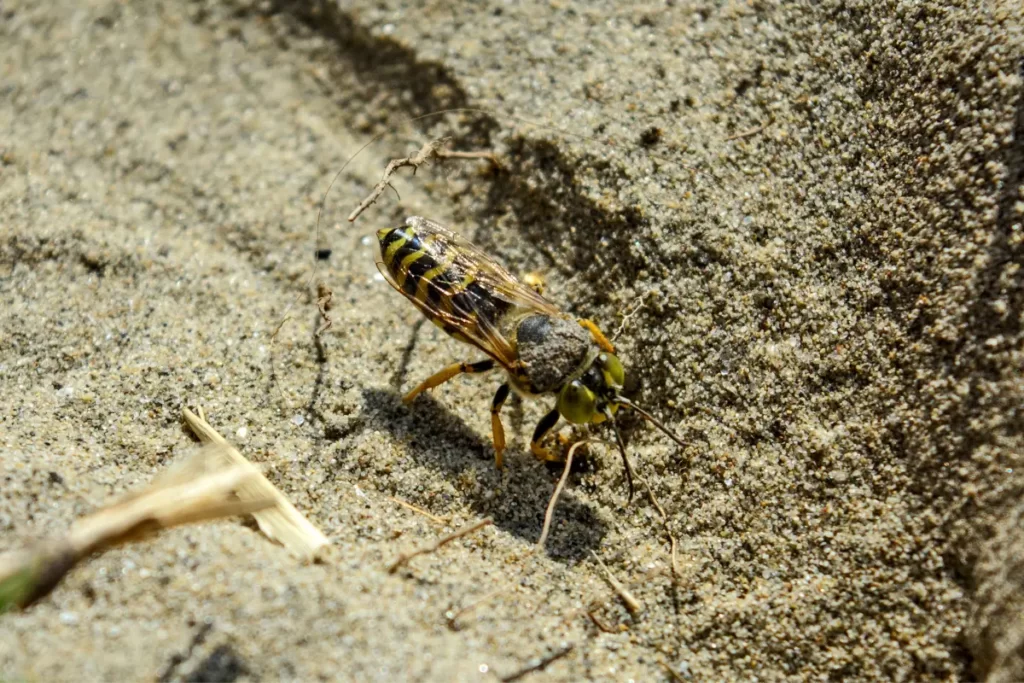
Sand Wasps are often found, as their name suggests, in sandy areas. Why? They’re expert diggers! These wasps create burrows in the sand where they lay their eggs. But that’s not all.
They also catch and paralyze insects, placing them in the caves as a fresh meal for their soon-to-hatch offspring. It’s a unique and efficient way of ensuring their young have a head start.
If you think they sound fearsome, worry not! Sand Wasps are generally not aggressive towards humans. Their primary interest lies in their sandy homes and hunting.
To help you identify these beach-loving wasps, here’s a detailed breakdown:
| Feature | Description |
| Size | About 1 to 3 cm in length. |
| Color | Typically black, brown, or reddish with distinct markings. |
| Body | Sleek with a clear segmenting waist. |
| Wings | Two pairs, often clear or lightly tinted. |
| Antennae | Yes, quite prominent and whisker-like. |
| Legs | Six, slender, designed for digging in the sand. |
- Short-Tailed Ichneumon Wasp
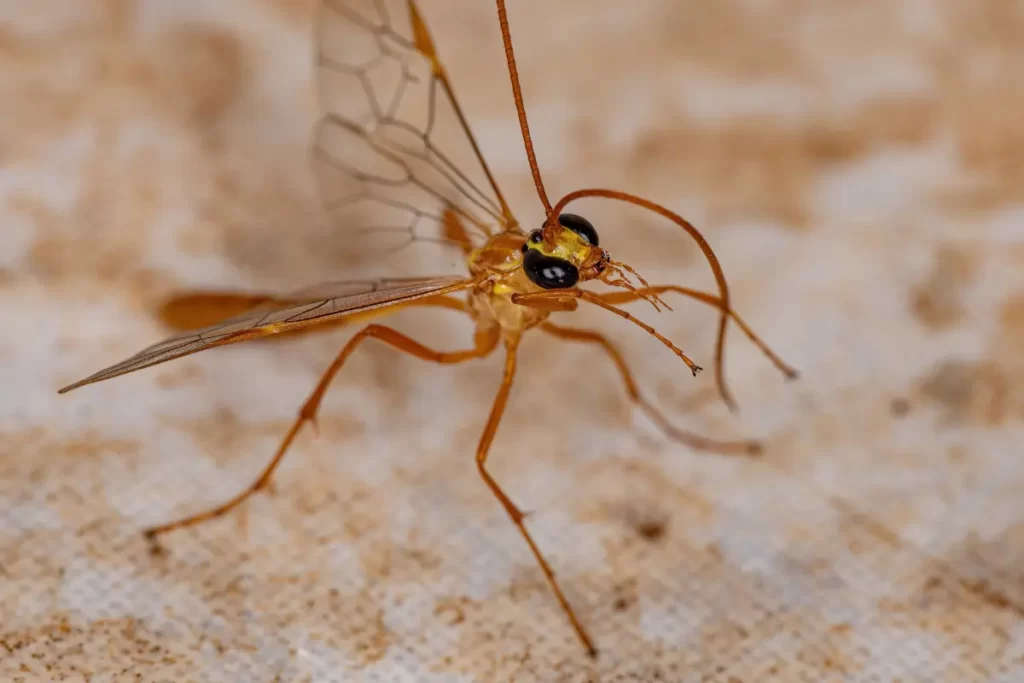
Unlike some of its relatives, the Short-Tailed Ichneumon Wasp has a shorter “tail” or ovipositor. But be aware of its size; this tool is effective! Female wasps use it to lay eggs inside host insects.
As these eggs hatch, they feed on the host, ensuring the next generation of wasps. It might seem a tad gruesome, but it’s nature’s method of keeping other insect populations in check.
For those who might be uneasy, here’s comforting news: these wasps are harmless to humans. They’re more interested in their insect hosts than anything else.
To get a clear picture of this wasp, let’s dive into its features:
| Feature | Description |
| Size | Roughly 1.5 to 3 cm in length. |
| Color | Brown or black, sometimes with light stripes or spots. |
| Body | Slender with a distinct but shorter ovipositor. |
| Wings | Two pairs, mostly clear with a slight tint. |
| Antennae | Yes, long and often thread-like. |
| Legs | Six, thin and delicate. |
- Weevil Wasp
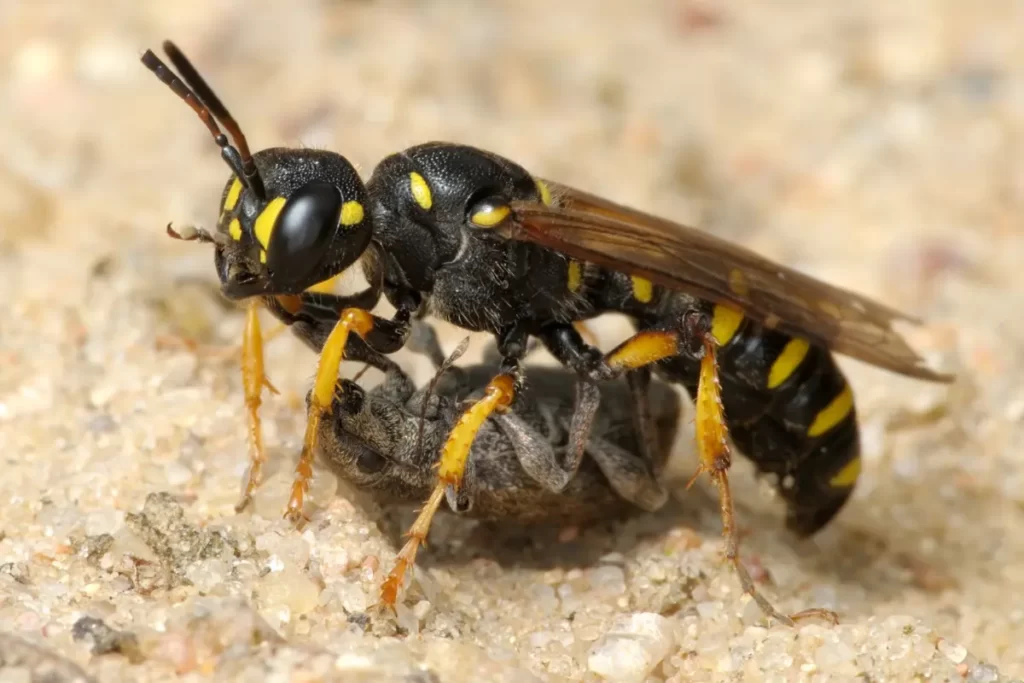
Oregon’s rich tapestry of insect life hides many unsung heroes. Among these, the Weevil Wasp stands out. It’s not just a wasp; it’s a fascinating mini-predator that showcases nature’s ingenuity.
Weevil Wasps are adept hunters with a special taste for weevils. If you’re wondering about weevils, they’re small beetles, and some can be pests. These wasps hunt them down, laying their eggs inside. When the eggs hatch, the larval wasps have a ready-made meal. This unique lifecycle ensures the wasp’s survival and helps control potential weevil outbreaks.
For those worried about a sting, there’s good news. Weevil Wasps are generally not interested in humans and pose no threat.
Here’s a closer look at the Weevil Wasp’s features:
| Feature | Description |
| Size | Usually 1 to 2.5 cm in length. |
| Color | Black, sometimes with metallic blue or green hues. |
| Body | Slim, with a noticeable waist between thorax and abdomen. |
| Wings | Two pairs, often clear with a metallic sheen. |
| Antennae | Yes, typically long and segmented. |
| Legs | Six, often slender and adapted for grabbing. |
- Spider Wasp
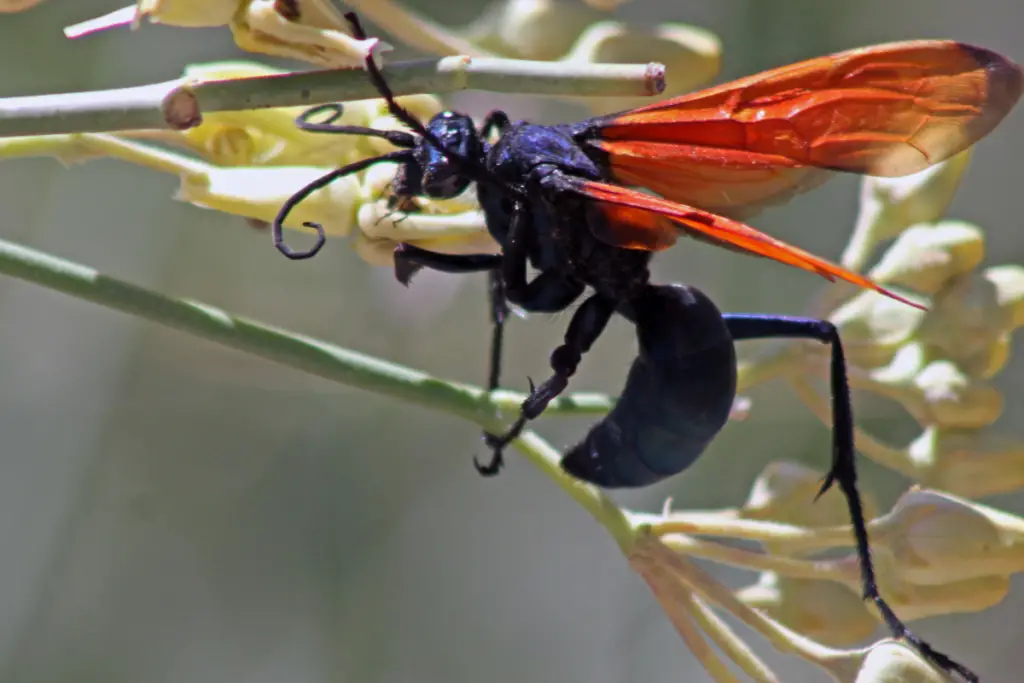
Meet the Spider Wasp: an insect brave enough to take on spiders! Its name isn’t just for show; it has a real connection to these eight-legged creatures.
Spider Wasps have a unique hunting strategy. They search for spiders, paralyze them with their sting, and then lay their eggs on them. When the wasp larvae hatch, they have a ready food source. It’s a survival technique that showcases the intricate dance of predator and prey in nature.
This might sound like a beneficial relationship for those who aren’t fans of spiders. And for most humans, Spider Wasps pose no real threat. They’re more focused on their eight-legged quarry.
Let’s delve into the physical features of the Spider Wasp:
| Feature | Description |
| Size | About 2 to 4 cm in length. |
| Color | Mostly black, with variations of red, orange, or blue. |
| Body | Sleek and elongated with a defined waist. |
| Wings | Two pairs, often dark-tinted or smoky. |
| Antennae | Yes, long and whip-like. |
| Legs | Six, long and slender, perfect for hunting. |
- Potter Wasps
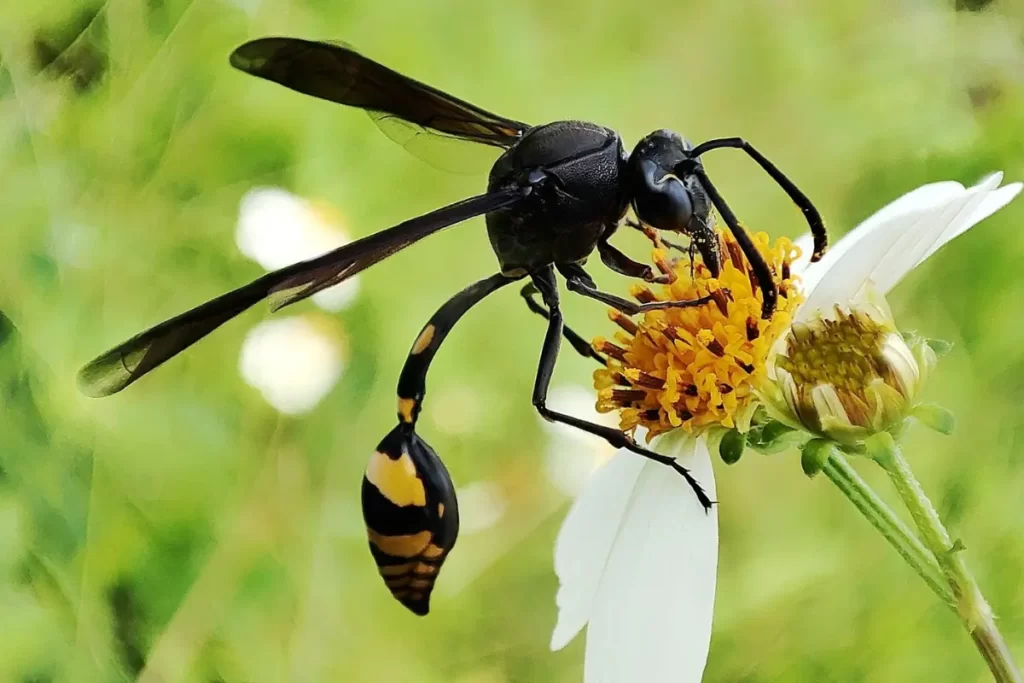
Potter Wasps are named for their unique nests. Just like a potter shapes clay, these wasps mold mud. They craft small, pot-shaped nests to house their eggs. And what do they fill these pots with? Caterpillars! The wasp larvae have a ready meal when they hatch. It’s nature’s take on a packed lunch.
Potter Wasps are a dream neighbor for those who enjoy peace. They’re non-aggressive and usually mind their own business, focusing on their craft and caterpillar hunting.
Now, let’s get to know the Potter Wasp a bit more intimately through its physical attributes:
| Feature | Description |
| Size | Typically 1 to 2 cm long. |
| Color | Varied, from black and brown to red and orange patterns. |
| Body | Sleek with a noticeable narrowing between the thorax and abdomen. |
| Wings | Two pairs, often semi-transparent with a tint. |
| Antennae | Yes, and they’re pretty long and curved. |
| Legs | Six, adept for both walking and gripping. |
- Boll’s Potter Wasp
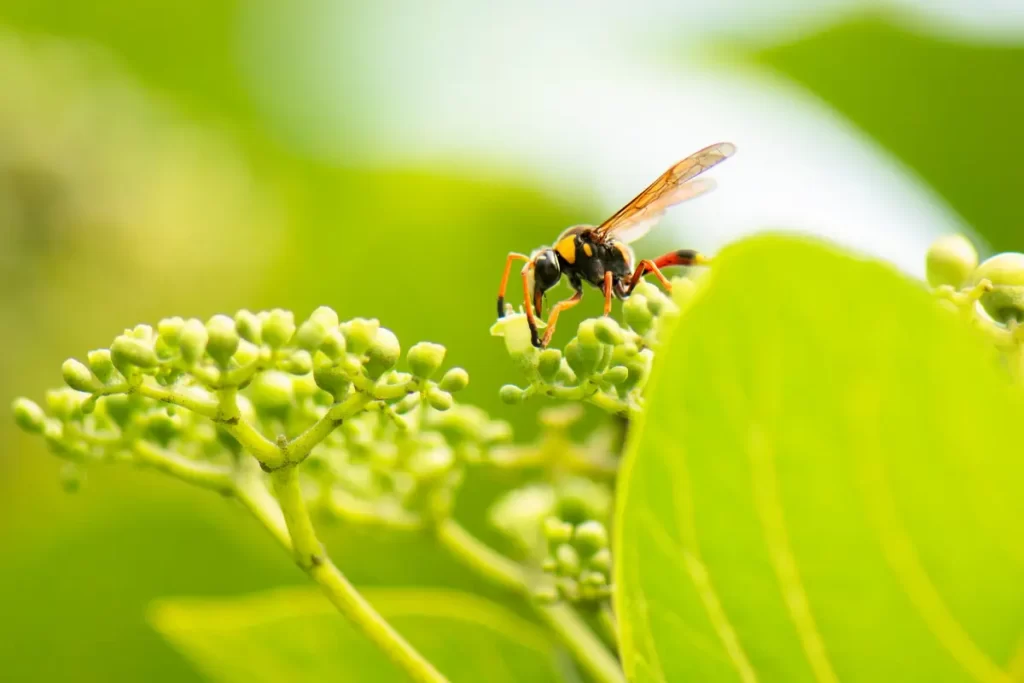
When one thinks of Oregon’s diverse wildlife, grand mammals and colorful birds might come to mind. But the Boll’s Potter Wasp? It’s a lesser-known jewel, a tiny insect with an artist’s touch. Hidden within the state’s rich tapestry of creatures, this wasp stands out for its creativity and purpose.
As its name suggests, the Boll’s Potter Wasp is a master builder. Using mud and clay, it crafts small, delicate pots, resembling miniature pottery.
These aren’t just for show! Inside these pots, the wasp places paralyzed caterpillars and lays its eggs. As the young wasps emerge, they have an instant food source, all thanks to the foresight of their parent.
For those wondering about its temperament, this wasp is generally peaceful. It’s more engrossed in its pot-making and caterpillar-hunting than bothering humans.
Here’s a snapshot of the Boll’s Potter Wasp’s characteristics:
| Feature | Description |
| Size | Roughly 1.5 to 2.5 cm in length. |
| Color | Brown with patterns of black and sometimes orange. |
| Body | Streamlined, with a pronounced waist. |
| Wings | Two pairs, clear with a subtle shimmer. |
| Antennae | Yes, slender and slightly bent. |
| Legs | Six, agile, suited for its active lifestyle. |
- Parasitic Wasps
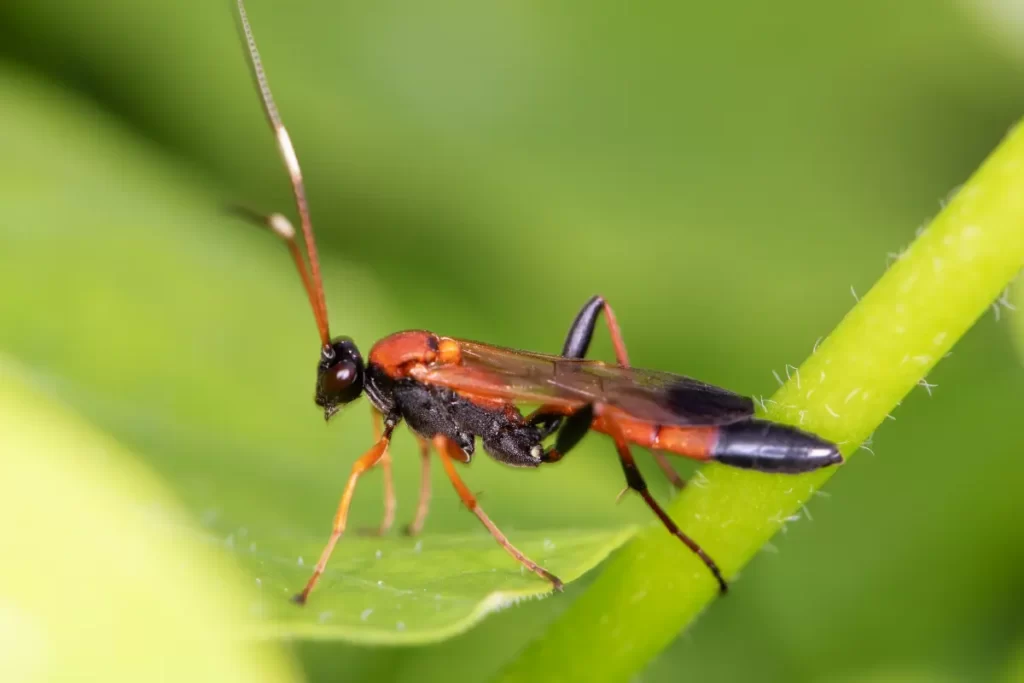
Among Oregon’s green expanses and dense woodlands, a tiny yet significant insect is hard at work. The Parasitic Wasp, though small, plays a gigantic role in controlling pests. Far from your typical wasp, this one doesn’t build nests or produce honey. Instead, it’s on a mission of a different sort.
Parasitic Wasps have a special life cycle. Instead of creating hives, they lay their eggs inside or on top of other insects, often pests. As their larvae grow, they consume the host insect. While this might sound a bit eerie, it’s nature’s way of keeping things balanced. These wasps help control insect populations, which can be a boon for gardens and farms.
And for those worried about stings, take a breather! Most Parasitic wasps are harmless to humans and prefer to stay focused on their insect hosts.
Dive into a snapshot of the Parasitic Wasp’s physical features:
| Feature | Description |
| Size | Generally 0.5 to 2 cm, but can vary based on species. |
| Color | Usually brown or black, sometimes with metallic hues. |
| Body | Slim, sometimes with a thin waist. |
| Wings | Two pairs, mostly transparent. |
| Antennae | Yes, often long and whip-like. |
| Legs | Six, slender, and built for precision. |
- Long-Tailed Ichneumon Wasps
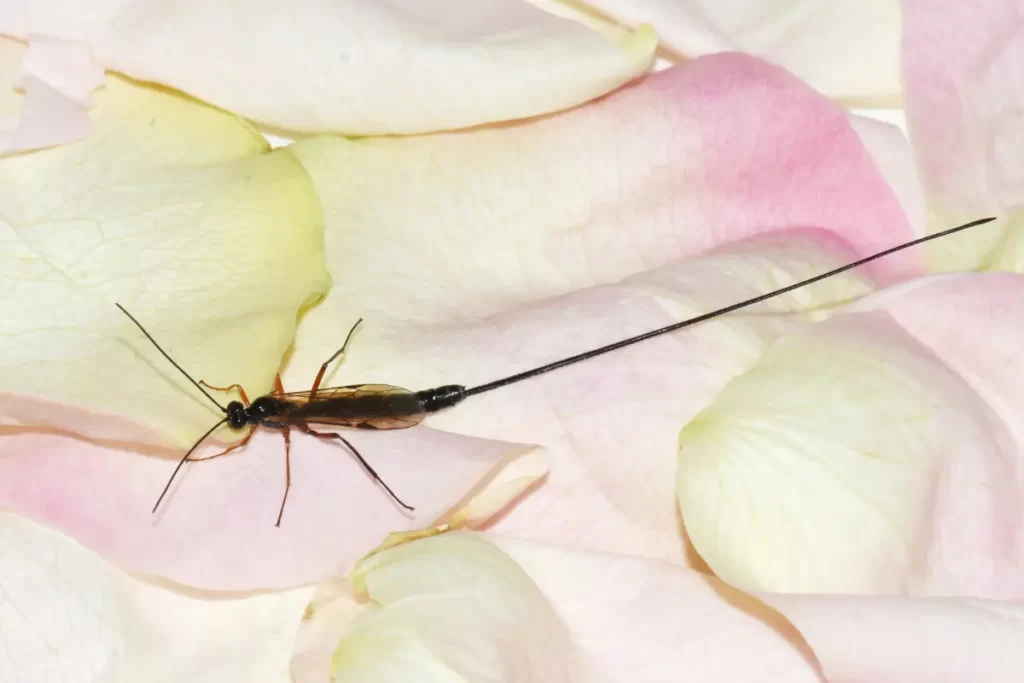
The Long-Tailed Ichneumon Wasp’s ovipositor isn’t for stinging, but for laying eggs. The wasp uses it to deposit eggs inside the wood where potential host larvae reside.
As the wasp larvae grow, they feed on the host, ensuring a nutrient-rich start to their life. This life cycle has rendered them beneficial, as they help control wood-boring pests.
The good news for us? These wasps are not aggressive towards humans. Their focus is solely on their role in nature, ensuring the next generation of wasps.
Get acquainted with the physical attributes of the Long-Tailed Ichneumon Wasp:
| Feature | Description |
| Size | About 1 to 3 cm, not including the ovipositor. |
| Color | Predominantly black or brown, with variations among species. |
| Body | Sleek and slender. |
| Wings | Two pairs, mostly clear with fine veining. |
| Antennae | Yes, thin and longer than their body. |
| Legs | Six, slim and nimble. |
| Ovipositor | Exceptionally long, sometimes several times the body length. |
- Braconid Wasps
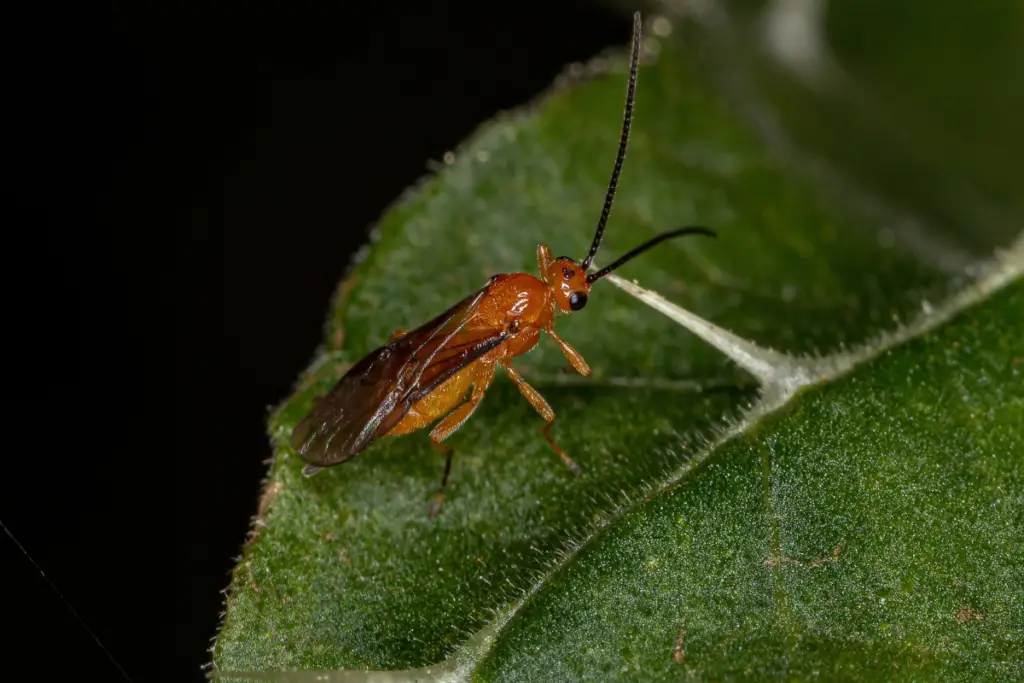
In Oregon’s bustling insect world, Braconid Wasps hold a significant place. At first glance, these tiny creatures may seem ordinary, but their impact on the environment is anything but! These little wonders have a unique role, acting as a natural check on many garden pests. Let’s delve deeper into the world of Braconid Wasps.
Braconid Wasps are known as “parasitoids.” That means they lay their eggs inside or on host insects. When their larvae hatch, they feed on the host, ultimately leading to its demise. But don’t worry!
These wasps mainly target pests, making them an ally for gardeners and farmers. Plus, for those of us who aren’t too fond of insects, it’s a relief to know that Braconid Wasps are gentle and won’t sting humans.
Familiarize yourself with the physical traits of the Braconid Wasp:
| Feature | Description |
| Size | Tiny, generally ranging from 1 mm to 1.5 cm. |
| Color | Varies widely, from black and brown to bright colors. |
| Body | Compact, with a robust build. |
| Wings | Two pairs, clear and veined. |
| Antennae | Yes, often long and slightly curved. |
| Legs | Six, adept for gripping their host insects. |
- Squarehead Wasp
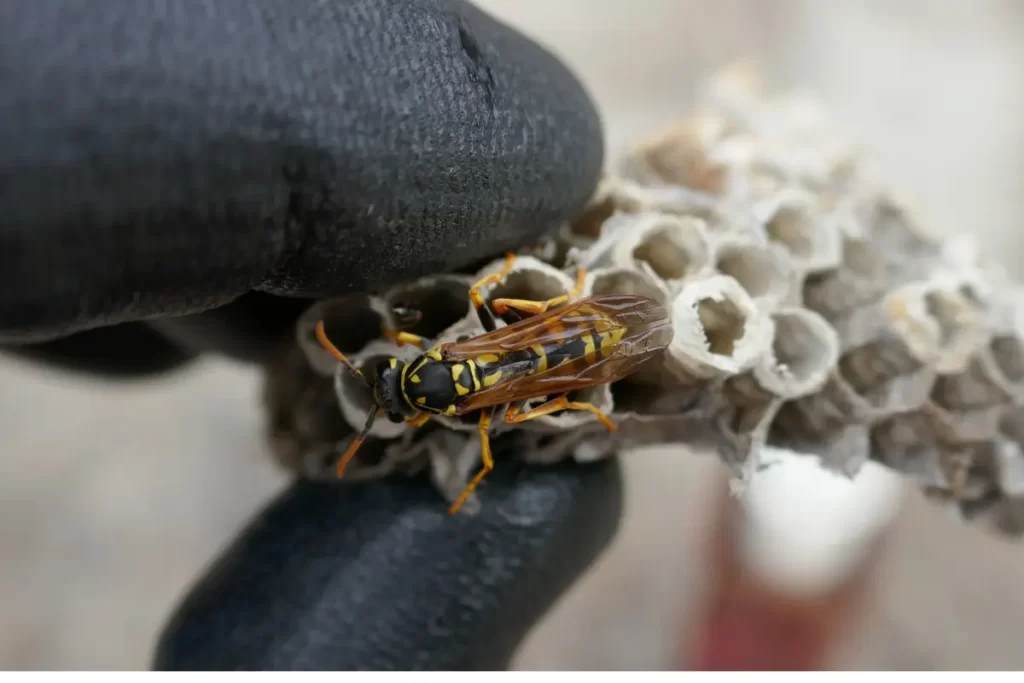
For the Squarehead Wasp, the name aptly describes its broad, flat head. But there’s more to these insects than just their shape.
Squarehead Wasps are part of the natural balance of Oregon’s ecosystem. They’re hunters, seeking out spiders to feed their young.
But instead of consuming the spider, the wasp paralyzes it and uses it as a living meal for its offspring. This might sound a tad grisly, but it’s nature’s way. The upside? If you’re not a fan of spiders, these wasps are your allies.
Now, let’s dive into the distinctive physical features of the Squarehead Wasp:
| Feature | Description |
| Size | Typically around 1 to 2 cm in length. |
| Color | Often metallic, ranging from green to blue to bronze. |
| Body | Elongated with a uniquely broad, squared-off head. |
| Wings | Two pairs, clear and membranous. |
| Antennae | Yes, moderately long and antenniform. |
| Legs | Six, sturdy and adept for hunting. |
Habitat & Distribution of Oregon Wasps
Habitat
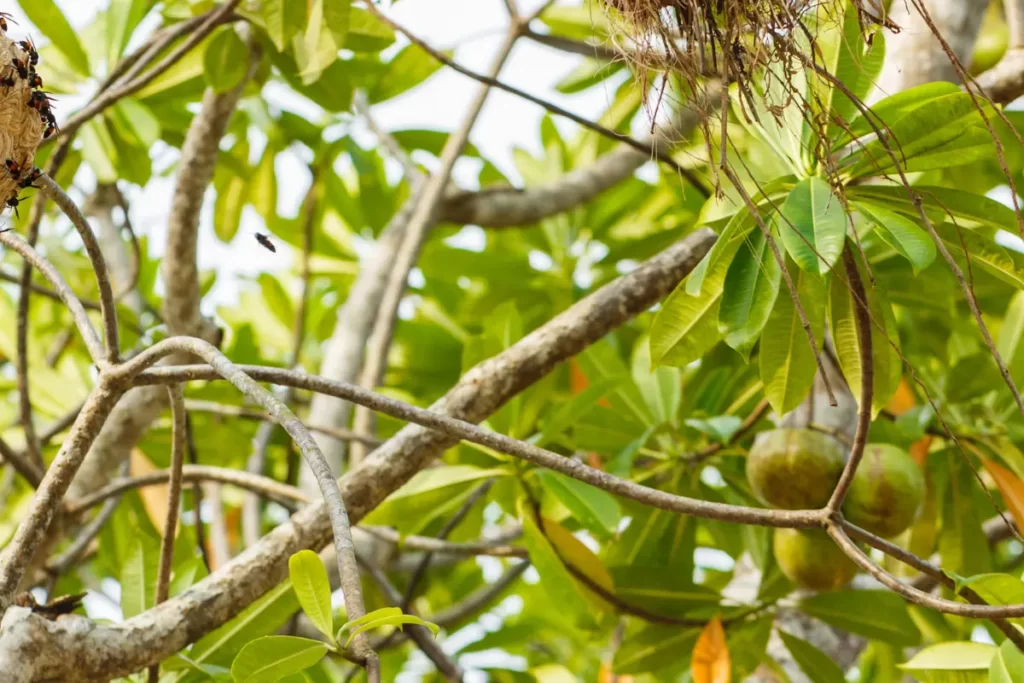
Wasps in Oregon occupy a variety of habitats. Their adaptability and diversity allow them to thrive in a broad range of environments. From dense forests to sunlit meadows and even urban areas, wasps have carved out their niche.
| Habitat Type | Description |
| Forests | Dense, wooded areas with abundant plant life. Ideal for wasps seeking shelter and hunting grounds. |
| Meadows | Open fields with wildflowers attract wasps, providing nectar and ample prey like caterpillars. |
| Urban Areas | Parks, gardens, and even buildings can be home to certain wasp species that adapt to human environments. |
| Riverbanks | The moist environment near water sources offers a habitat for wasps that prey on aquatic larvae. |
| Mountain Regions | High-altitude areas with specific flora that attract wasp species adapted to cooler climates. |
Distribution

Oregon’s diverse landscape means wasps are spread out across the state. The distribution varies based on the species and their specific environmental preferences. Some are widespread, while others might be concentrated in particular areas.
| Region in Oregon | Description |
| Coastal Areas | The mild climate of Oregon’s coast attracts a variety of wasps, from sand-loving species to those in coastal forests. |
| Valleys | Rich in vegetation and prey, valleys are prime spots for many wasp species. |
| Eastern Plateaus | Dryer areas with specific flora that cater to drought-resistant wasp species. |
| Cascade Range | Mountainous regions with cooler climates might have specialized species adapted to the altitude and temperature. |
| Urban Centers | Cities like Portland, Salem, and Eugene might have wasps that have adapted to urban life, often seen in parks and gardens. |
Wasp Behavior and Diet
Wasps are some of nature’s most fascinating creatures. Despite their often-feared sting, wasps play a vital role in the ecosystem. So, what makes these insects tick? Let’s dive deep into their behaviour and diet.
Behavior
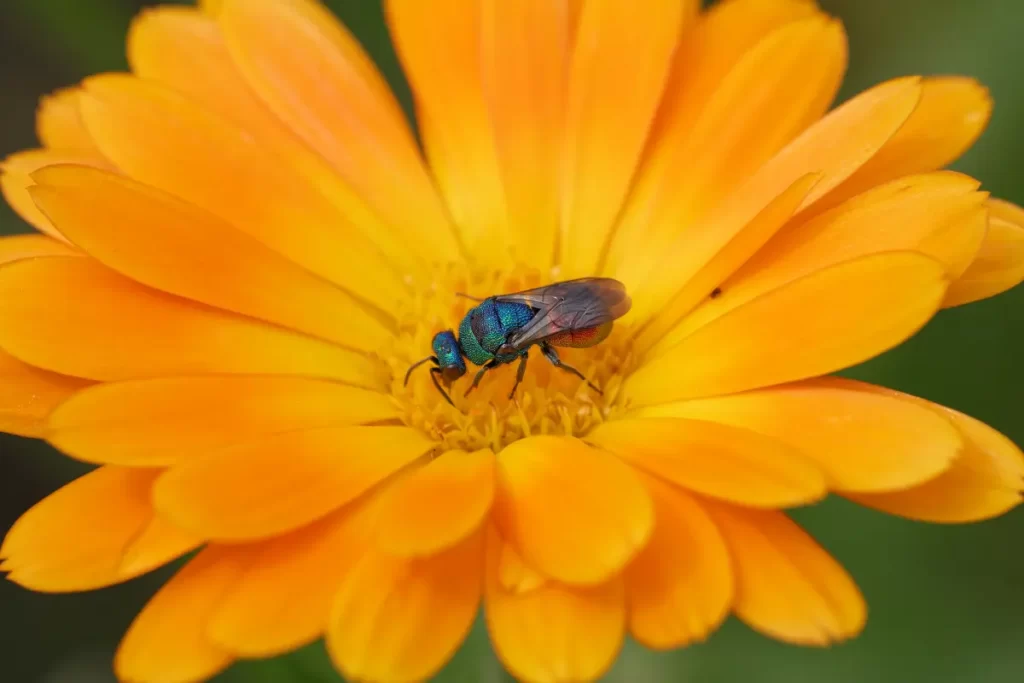
Wasps are known for their social structure. Many live in colonies led by a single queen, much like bees. However, some solitary wasp species prefer to go about their life alone.
These creatures are territorial, especially when they feel their nest is threatened. Another notable behavior is their flight pattern. Watch a wasp, and you’ll notice they have a purposeful flight, often darting back and forth as they seek food or return to their nests.
Diet
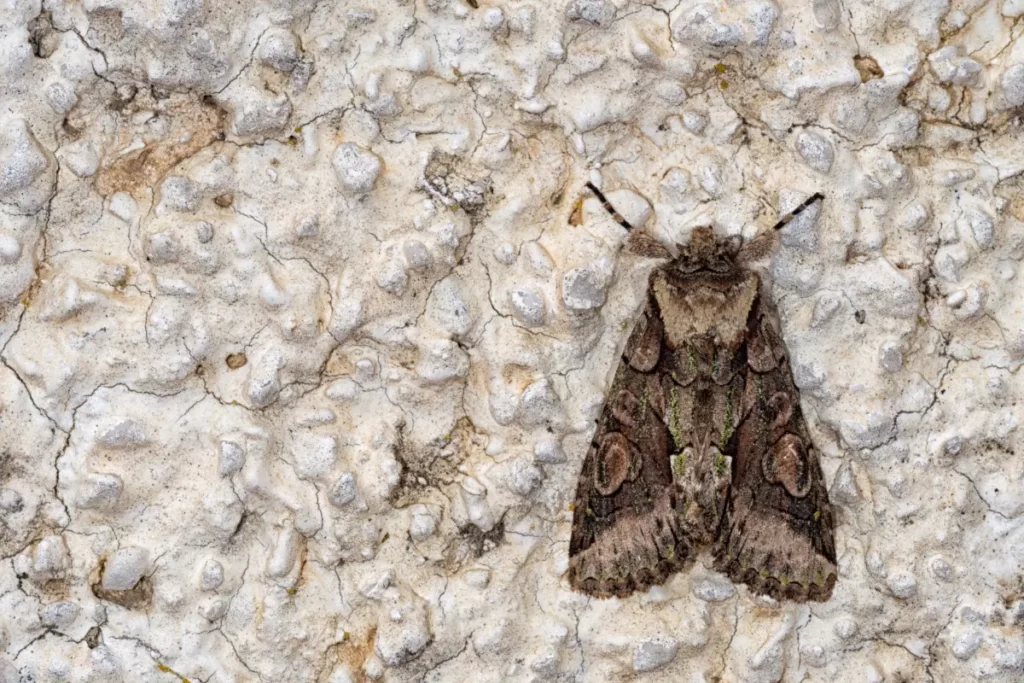
Wasps aren’t just about stinging; they have a varied diet. Most adult wasps, for instance, feed primarily on nectar. They act as pollinators in this process, transferring pollen from one flower to another.
But, they are also predators. Many wasps hunt other insects, capturing them to feed their larvae. This hunting behavior makes them essential for controlling pest populations.
Nesting Habits
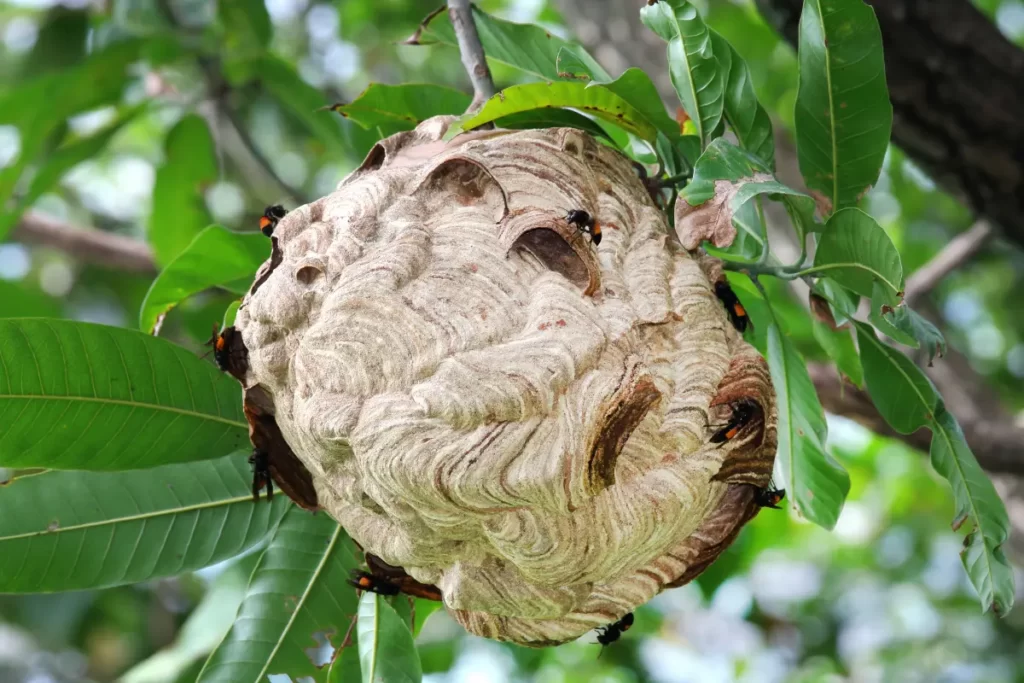
Wasps are expert builders. Depending on the species, they create different types of nests using various materials. Some common nesting habits include:
- Paper Wasps: True to their name, they craft nests that look like paper. These nests, often umbrella-shaped, hang from trees or eaves.
- Mud Daubers: These wasps use mud to build tube-like nests, typically found on the side of buildings or under eaves.
- Ground Wasps: Some wasps prefer to live underground. They dig burrows in sandy or soft soils.
- Cavity Nesters: These wasps, including the hornet, use existing spaces like hollow trees or cavities in walls to build their homes.
What Oregon Wasps Feed On?
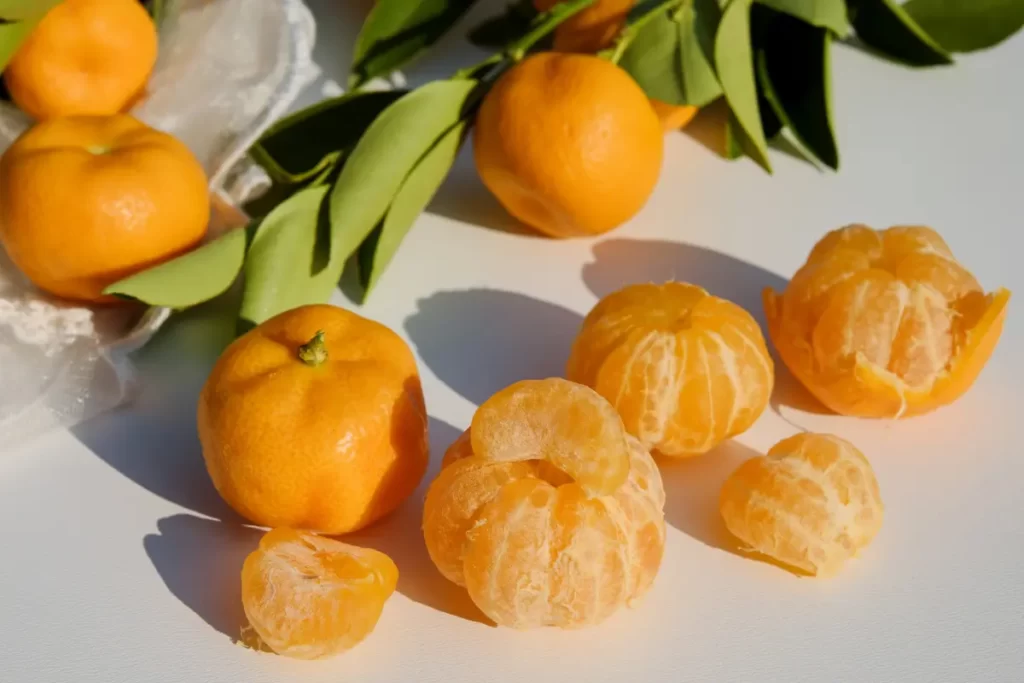
| Wasp Type | Diet |
| Adult Wasps | Nectar, honeydew, and sugary secretions. Some might even feed on ripe fruits. |
| Predatory Wasps | Insects like caterpillars, spiders, and even other wasps. They paralyze their prey and feed them to their larvae. |
| Parasitic Wasps | Don’t feed on insects directly but lay their eggs inside or on them. The larvae feed on the host once they hatch. |
| Social Wasps | A mix of plant-based foods and other insects. Often hunt in groups and share food with larvae in the colony. |
Dealing with Wasp Nests in Oregon
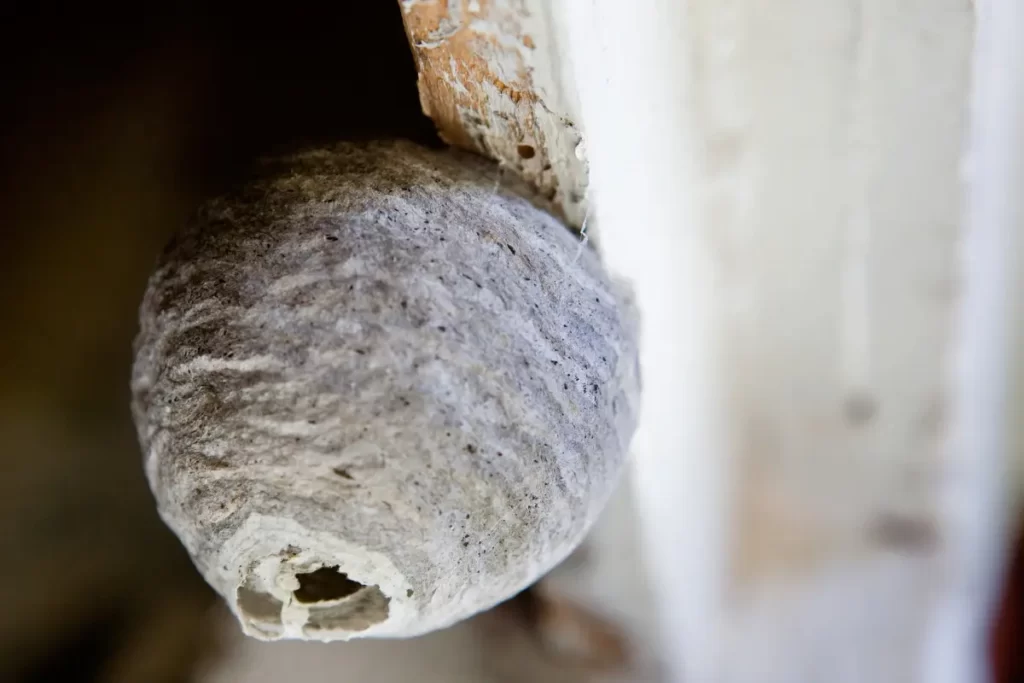
If you live in Oregon, you’ve probably encountered a wasp nest at some point. While wasps play a crucial role in our environment, having a nest near your home can be unsettling and sometimes dangerous. Let’s discuss how to deal with these nests safely and effectively.
Identifying the Nest: Before taking any action, ensure you’re dealing with wasps and not bees. Bees are vital pollinators and are often protected. Their nests are typically more rounded and are made up of hexagonal cells. Wasp nests, depending on the species, can look papery or muddy.
Keep Your Distance: If you find a wasp nest, it’s essential to maintain a safe distance. Wasps can become aggressive if they feel their nest is threatened. Remember, the larger the nest, the more wasps it contains. A sizable nest can house thousands of wasps ready to defend their home.
Call the Pros: For larger nests or unsure how to proceed, it’s always best to call pest control professionals. They have the tools, knowledge, and protective gear to remove wasp nests safely.
DIY Removal: If you decide to tackle a smaller nest on your own, ensure it’s done during the night when wasps are less active. Wear protective clothing, including gloves and a face mask. Use a store-bought wasp spray, and always follow the manufacturer’s instructions.
Prevent Return: After a nest has been removed, take measures to ensure wasps don’t return. Seal off openings in your home, keep garbage cans sealed, and regularly inspect your property for new nests.
Safety Precautions
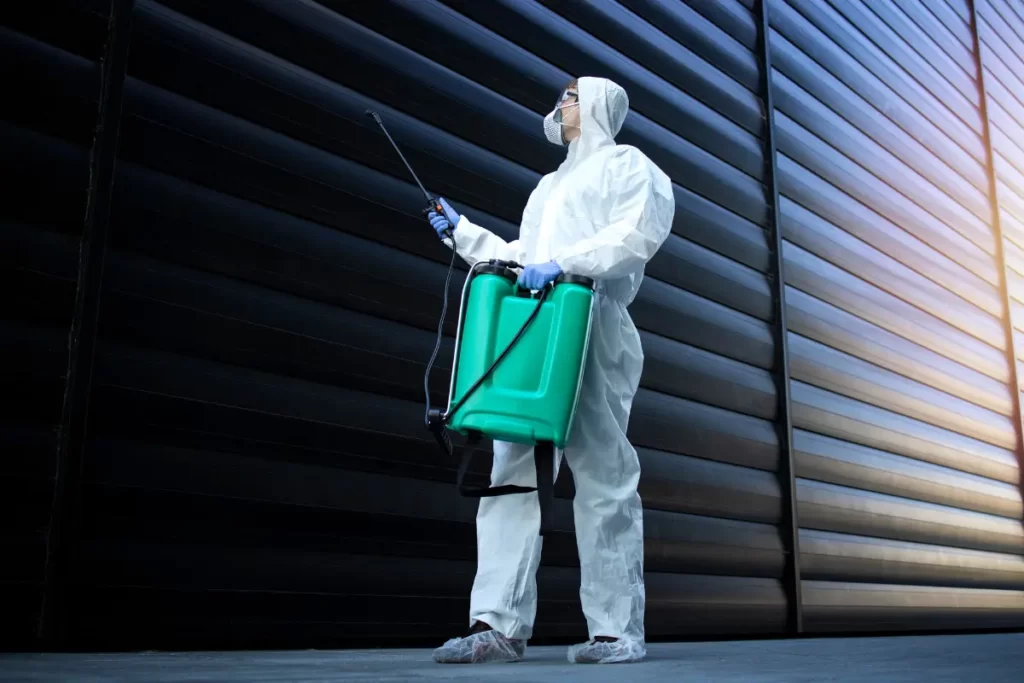
Your safety is paramount. If you’re dealing with or are around wasps, follow these precautions:
- Avoid Sudden Movements: If a wasp flies around you, remain calm. Avoid swatting at it, as this can provoke it. Instead, move slowly away from the area.
- Wear Protective Clothing: If you plan to be near a nest, wear long sleeves, pants, and closed-toed shoes. Wear gloves and some form of eye protection is also a good idea.
- Be Aware of Allergies: Some people are allergic to wasp stings, and a single sting can trigger a severe allergic reaction. If you’ve been stung and start experiencing symptoms like difficulty breathing, facial or throat swelling, or dizziness, seek medical attention immediately.
- Keep Food Covered: If you’re eating outdoors, keep Food and drinks covered. Wasps are attracted to sugary foods and protein.
- Avoid Strong Scents: Strong perfumes, lotions, or even hair products can attract wasps. If you’re going to be in an area where wasps are prevalent, opt for unscented products.
16 Natural Remedies to Kill Wasps

Wasps are common in many parts of Oregon. While they play an essential role in the environment, they can also pose challenges for homeowners and outdoor enthusiasts. If you’re seeking natural ways to deter these buzzing pests, here are some tried-and-true remedies:
- Peppermint Oil: Wasps dislike the scent of peppermint. You can create a natural wasp repellent by mixing a few drops of peppermint oil with water in a spray bottle. Spray this mixture around outdoor eating areas, doorways, and other places where you’ve seen wasps.
- Lemon and Clove: This is a classic and straightforward remedy. Cut a lemon in half and push about 10-12 cloves into each half. Place the lemon halves on a plate outside. Wasps dislike the scent and will generally keep away.
- Cucumber Slices: Believe it or not, wasps hate the taste of cucumber. The acid reacts with their body and they’ll avoid it. Slice a cucumber and place the slices where wasps are a problem.
- Sugar and Water Trap: While this uses sugar to attract wasps, it’s a way to reduce their number. Fill a container with water and sugar, and place it near the wasp problem area. Wasps will be drawn to the sweet solution, but they’ll get trapped in the water.
- Plant Repellent Plants: Some plants naturally repel wasps. These include wormwood, eucalyptus, mint, and citronella. Planting these in your garden or placing pots around your outdoor areas can deter wasps.
- Baby Powder: Another surprising remedy is baby powder. For some reason, wasps and many other insects dislike it. If you know where wasps are entering your home, sprinkle baby powder around that area.
- Vinegar: Vinegar can serve as a base for many repellent sprays. Mix it with an equal amount of water, and you can spray this mixture around areas where you want to deter wasps.
- Soap Solution: A mixture of soap and water can be an effective means to deal with wasps. When sprayed directly onto them, the soapy water clogs their breathing pores, and they perish. Fill a spray bottle with water and add a good amount of dish soap. Spray directly onto wasps or the nest, but be cautious and prepared for them to become agitated.
- Vanilla Extract: Another pleasant aroma for humans but not so much for wasps is vanilla. Mix a tablespoon of vanilla extract with a cup of water and pour it into a spray bottle. Spray areas you want to keep wasp-free.
- Avoid Sweet Scents: This isn’t a remedy per se, but more of a preventive measure. Wasps are drawn to sweet smells. Avoid wearing sweet perfumes or lotions when you’re spending time outdoors. Also, ensure that food, especially sweet food, is covered when eating outside.
- Red Wine Trap: Wasps are attracted to wine, but it can also serve as a trap. Place a little red wine in a bowl, and the wasps will be drawn to it, but they’ll become intoxicated, preventing them from leaving.
- Brown Paper Bags: A rather interesting and simple trick is to inflate a brown paper bag and tie it closed. Hang this in areas you want to keep wasp-free. It resembles a hornet’s nest, and wasps will avoid the area thinking it’s already claimed.
- Chalk: Some claim that drawing a line with chalk around the area you want to keep wasp-free can deter them. It’s believed wasps won’t cross such a line, though it’s not entirely clear why.
- Wasp-Repelling Herbs: Growing herbs like thyme, pennyroyal, and spearmint can repel wasps. You can plant them in areas where you’ve noticed wasp activity.
- Essential Oils: Apart from peppermint, there are several essential oils wasps dislike. Eucalyptus, citronella, and lemongrass oils can be mixed with water and sprayed in areas where you want to deter wasps.
Coexisting with Wasps
Though often feared, wasps play an essential role in our ecosystem, acting as pollinators and natural pest controllers. Instead of viewing them as pests, we can learn to live in harmony. Here’s how:
- Appreciate Their Role: Understand that wasps are beneficial. They feed on many pests that damage our gardens and crops. They also serve as pollinators for certain plants.
- Observe from a Distance: If you see wasps, avoid disturbing them. Watch and appreciate their intricate behaviors and marvel at nature’s design.
- Provide Them Space: If there’s a wasp nest far from your living spaces, consider letting it be, especially if it poses no immediate threat.
Avoiding Stings
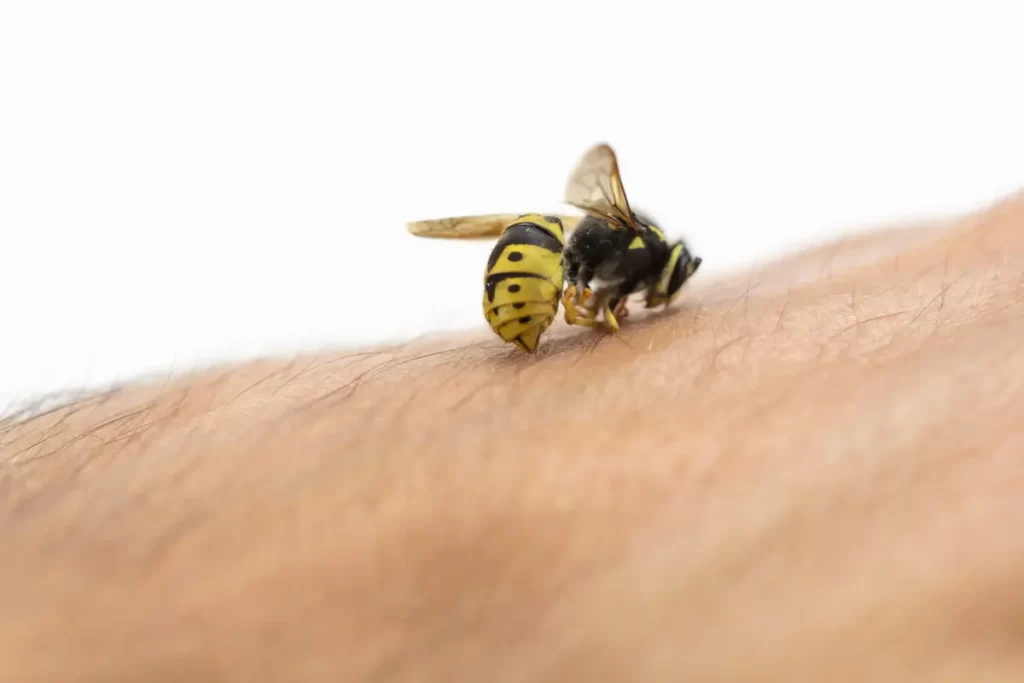
While wasps are fascinating, they can sting, especially when they feel threatened. Here’s how to reduce the chances of getting stung:
- Stay Calm and Move Slowly: If a wasp flies near you, remain calm. Avoid sudden movements. Rapid actions can provoke them.
- Avoid Bright Colors and Scents: Wasps are attracted to bright colors and strong scents. When outdoors, wear neutral colors and avoid floral patterns. Also, minimize the use of perfumes or colognes.
- Cover Food and Drinks: When eating outside, keep food covered. Open drinks can attract wasps, so use covered containers or check before sipping.
- Be Aware of Nest Locations: Stay vigilant and be on the lookout for nests, especially during late summer when wasp numbers are at their peak.
Safely Removing Nests
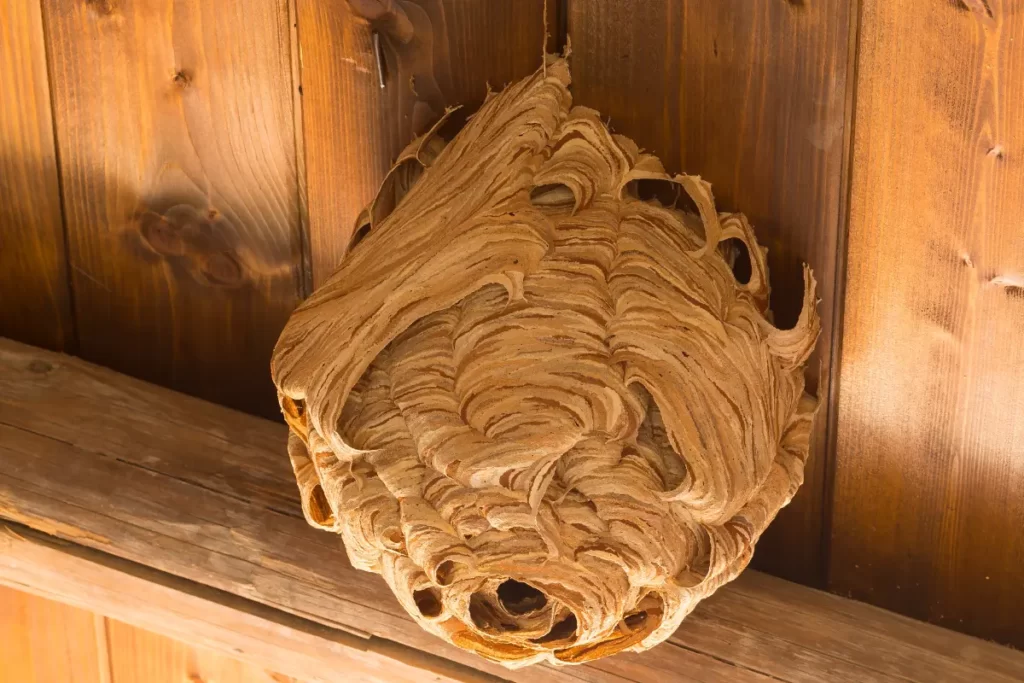
While coexistence is encouraged, there are times when a wasp nest might be too close for comfort. If you decide to remove a nest:
- Time it Right: Early morning or late evening, when wasps are less active, is the best time for nest removal.
- Wear Protective Clothing: Put on a long-sleeved shirt, pants, gloves, and a hat. Use a scarf or face mask and wear glasses or goggles for added protection.
- Use Soap and Water: A mixture of soap and water sprayed directly onto the nest can be effective. It clogs the wasps’ spiracles (breathing tubes), incapacitating them.
- Avoid Using Pesticides: These can be harmful to the environment and might not be effective unless directly applied. Plus, they can provoke the colony.
- Consider Relocation: If you’re brave and skilled enough, you can transfer a nest to a safer location. This is a complex task, so if you’re unsure, seek expert help.
- Consult a Professional: If a nest is large or in a difficult-to-reach location, it’s safer to call a pest control professional. They have the knowledge and tools to remove nests without risks.
Remember, wasps are an integral part of our ecosystem. By understanding and respecting their space, we can coexist without conflict.
Other Major Wasp Types Found in The USA
Although we have written this detailed guide for Oregon wasps, still other wasp species are commonly found in the USA, you can find everything about these species here:
Conclusion
Wasps, commonly found in Oregon, are more than just buzzing insects with stingers. They play a vital role in our environment, helping control pests and assisting in pollination.
While their presence can sometimes be alarming, it’s important to remember that they typically don’t attack unless provoked. We’ve explored their habits, diets, and various species, giving insights into their fascinating world.
Understanding their behavior and taking preventive measures can make a world of difference for those looking to coexist peacefully with wasps. And if a nest poses a threat, remember safety first! Natural remedies offer gentle ways to deal with them, but professional help is always a good option.
Let’s appreciate these creatures and their contributions to nature, ensuring a harmonious balance for all.
FAQs
Reference
Falahatpisheh, A., Fallahzadeh, M., Dousti, A.F., Strumia, F. and Saghaei, N., 2021. New records of two cuckoo wasp species (Hymenoptera: Chrysididae) from Iran. Journal of Insect Biodiversity and Systematics, 7(2), pp.137-143.
Taylor, B.A., Cini, A., Cervo, R., Reuter, M. and Sumner, S., 2020. Queen succession conflict in the paper wasp Polistes dominula is mitigated by age-based convention. Behavioral Ecology, 31(4), pp.992-1002.
Островский, А.М., 2020. First record of the family Leucospidae (Hymenoptera: Chalcidoidea) from the fauna of Belarus. Far Eastern Entomologist, (416), pp.15-17.
